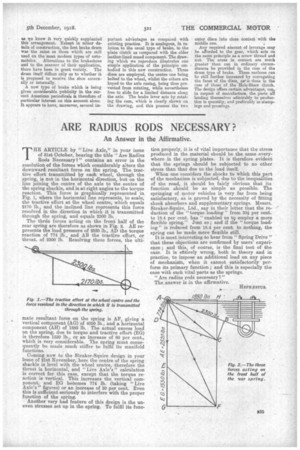ARE RADIUS RODS NECESSARY?
Page 13

If you've noticed an error in this article please click here to report it so we can fix it.
An Answer in the Affirmative.
ri-t HE ARTICLE by "Live Axle," in your issue • of 31st October, bearing the title "Are Radius Rods Necessary I" contains an error in the resolution of the forces which considerably alters the downward resultant force on the spring. The tractive effort transmitted by each wheel, through the spring, is not in the horizontal direction, but on the line joining the centre of the axle to the centre of the spring shackle, and is at right angles to the torque reaction. This force is graphically represented in Fig. 1, where the horizontal line represents, to scale; the tractive effort at the wheel centre, which equals 2170 lb., and the inclined line represents this force resolved in the direction in which it is transmitted through the spring, and equals 2300 lb.
The three forces acting on the front half of the rear "spring are therefore as shown in Fig. 2. AE represents the load pressure of 2520 lb., AD the torque reaction of 774 lb., and AB the tractive effort, or thrust. of 2300 lb. Resolving these forces, the ulti mate resultant force on the spring is AF, giving a vertical component (AG) of 4050 lb., and a horizontal component (All) of 1880 lb. The actual excess load on the spring, due to torque and tractive effort (EG) is therefore 1530 lb., or an increase of 60 per cent., which is very considerable. The spring must consequently be made much stiffer to fulfil its manifold functions.
Cuming now to the Straker-Squire design in your issue of 21st November, here the centre of the spring shackle is level with the wheel centre, therefore the thrust is horizontal, and "Live Axle's" calculation is correct for this case, except that the torque reaction is vertical. This increases the vertical component, and EG beeomes 774 lb. (taking "Live Axle's" figures) or an increase of 30 per cent. Even this is sufficient seriously to interfere with the proper function of the spring. Another very bad feature of this design is the uneven stresses set up in the spring. To fulfil its func tion properly, it is of vital importance that the stress produced in the material should be the same everywhere in the spring plates. It is therefore evident that the springs should be subjected to no other stress than that due to the load itself.
When one considers the shocks to which this part of the mechanism is subjected, due to the 'inequalities of the road, it should be fairly obvious that its function should be as simple as possible. The springing of motor vehicles is very far from being satisfactory, as is proved by the necessity of fitting shock absorbers and supplementary springs. Messrs. Straker-Squire, Ltd., say in their letter that the reduction of the "torque loading" from 33/ per cent. to 18.4 per cent. has "enabled us tcl employ a more flexible spring." Just so ; and if the "torque loading" is reduced from 18.4 per cent. to nothing, the spring can be made more flexible still. It is most interesting to hear from "Spring Drive" that these objections are confirmed by users' experience; and this, of course, is the final test of the case. It is entirely wrong, both in theory and in practice, to impose an additional load on any piece of mechanism, when it cannot satisfactorily perform its primary function ; and this is especially the case with such vital parts as the springs.
"Are radius rods necessary '? "
The .answer is in the affirmative.






















